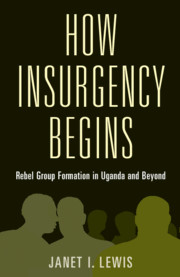Book contents
- How Insurgency Begins
- Cambridge Studies in Comparative Politics
- How Insurgency Begins
- Copyright page
- Contents
- Figures
- Tables
- Acknowledgments
- Part I Rethinking How Armed Conflicts Begin
- 1 Introduction
- 2 A Theory of Rebel Group Formation
- Part II Uganda and Beyond
- Part III Implications
- Book part
- References
- Index
- Series page
2 - A Theory of Rebel Group Formation
from Part I - Rethinking How Armed Conflicts Begin
Published online by Cambridge University Press: 18 September 2020
- How Insurgency Begins
- Cambridge Studies in Comparative Politics
- How Insurgency Begins
- Copyright page
- Contents
- Figures
- Tables
- Acknowledgments
- Part I Rethinking How Armed Conflicts Begin
- 1 Introduction
- 2 A Theory of Rebel Group Formation
- Part II Uganda and Beyond
- Part III Implications
- Book part
- References
- Index
- Series page
Summary
This chapter presents the book’s theory of rebel group formation. It argues that in weak state contexts, rebel groups typically start small and poor – and are therefore highly vulnerable to defeat. In an attempt to induce civilians to keep their secrets from the government, nascent rebels use early attacks and rumors to influence civilians’ perceptions of their capabilities and righteousness. Only in ethnically homogeneous localities are kinship networks structured in a manner that makes civilians susceptible to hearing and believing rebels’ rumors. Therefore, in ethnically homogeneous localities, rebels have a better chance of becoming a viable threat to the state’s authority. The chapter emphasizes that this theoretical account linking local ethnic homogeneity to rebel viability is quite different from those about ethnic grievances against the state. Instead, an implication of this theory is that grievances are not a necessary condition for ethnic rebellion, and in fact many grievances emerge out of the initial stages of violence. Another implication is that to deter and defeat nascent insurgents, states must build their local civil intelligence capacity.
Keywords
- Type
- Chapter
- Information
- How Insurgency BeginsRebel Group Formation in Uganda and Beyond, pp. 28 - 60Publisher: Cambridge University PressPrint publication year: 2020



